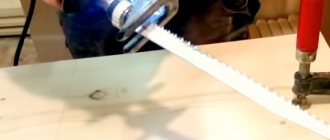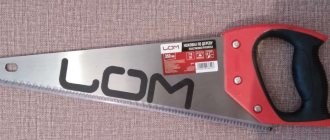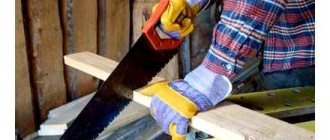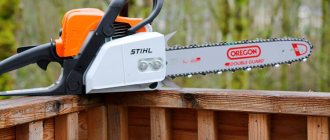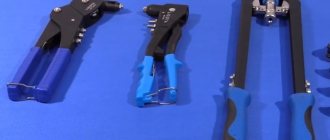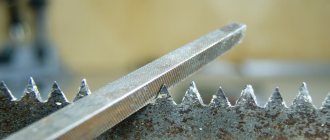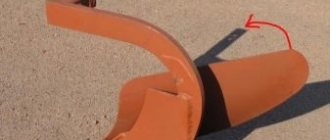Saws have been in use for thousands of years, evolving and expanding their variety to fill specific niches over time and advances in technology and materials. Today's "complete" collection of tools will include a variety of saws, from simple copy saws to complex combination machines and specialized table saws incorporating the capabilities of several hand saws.
We'll cover some specialized tools that have little use outside of the professions for which they were designed. Additionally, you may be surprised to find that many saws have different names in different countries.
In most cases, the shape of the saw and the number and shape of the teeth determine how the saw will be used.
Here are 26 different types of saws , their uses and pictures:
Individuality of hacksaws
What types of hacksaws are there for wood? There are different models of hand saws, but the most used ones are full-frame ones, equipped with 10-12-inch blades.
Regardless of the type of hacksaw, it is important to check that the product being offered is of high quality, made from a special steel alloy.
In the most modern versions, the blade is adjustable in length, which makes it possible to cut branches of different diameters.
- The cutting part is inserted into the pillars located on the frame.
- It can be positioned in any position, allowing it to be moved back and forth according to specific needs.
- Among the large selection of product types, all options have differences: in the shape of the handle; the size of the teeth; sizes and other characteristics.
The buyer needs to take into account his needs when selecting the working part and its dimensions. If you plan to cut boards and remove small branches, then you will need a product with a working blade width of 28-30 cm.
- For construction purposes, bases of 45-50 cm are used; larger sizes can also be found on sale, depending on what kind of work needs to be done.
- The effectiveness of the tools depends on the ratios - the thickness of a wooden part should be 2 times less than that of a file.
- Then you get more swinging movements, so you can implement the intended task faster.
Large teeth should go completely into the material, so the sawdust will come off.
Boning saw
At first glance, such a saw looks like a hacksaw and consists of a cutting blade and a handle. Such a device has a backing that is applied to the upper part of the metal sheet, giving the product rigidity. This is necessary so that the canvas performs its function smoothly and without hesitation. The blade of this tool has hardened teeth, which allows for precise cutting.
Features of Japanese technology of axing saws.
- The saw handle can be larger in size than the blade itself. It resembles the handle of a sword.
- Thin blade blade: up to one millimeter.
- The cut is made by moving towards you.
According to their shape and purpose, Japanese saws are divided into several types.
- Universal - they have a wide blade, their cutting teeth are located on both sides of the blade.
- To ensure product strength and limit the depth of cut, rectangular blades without limiters are used.
- Tools for long cuts.
- To remove knots and protrusions on wood, use products with a thin blade.
- Equipment for making wooden figurines.
- Devices for processing wooden products in hard-to-reach places.
Saws with gasoline engines from Japanese manufacturers are easy to operate and have fairly clear technical equipment. Such goods are sold at affordable prices even in the Russian Federation.
Japanese technologies for the production of gasoline saws are recognized throughout the world. Manufacturers take into account characteristics that are important for the efficiency of saw engines, such as mixture formation, compression ratios and channel shapes. Thus, their engines have a large power reserve, but at the same time the mass of the tool as a whole is preserved and gasoline consumption is reduced.
In addition, saws from Japan are distinguished by their environmental friendliness, safety and silent operation.
But a rather significant disadvantage of Japanese chainsaws is the high price not so much of the tools themselves, but of the components and maintenance.
The main advantages include:
- Long service life of the product even under high loads and in harsh climatic conditions.
- Compact weight, gas saving and high performance.
- Affordable price compared to European analogues.
- The equipment has a multi-stage cleaning system. It minimizes the release of toxins into the environment.
- Modern design that attracts the eye. It's nice to have such equipment in your arsenal of home appliances.
- A high-quality approach to the production of products, both economical options and professional saws.
Vivid examples of Japanese-made chainsaws include products from Echo. The saws of the presented company are enviably popular.
The most popular are the following models.
- Echo 350. The engine has a built-in pump that pumps fuel, and there is also a device for easy starting of the unit. The main difference from other similar equipment is the harmonious combination of weight, power and production technology. The large engine capacity is one of the advantages over competitors.
- Echo 3500. A small but quite powerful chainsaw. It differs from its competitors in its reliability and stability. Easy to use and does not require professional skills to operate.
- Echo 353. This model is most often used by farmers. High quality, environmental friendliness, and simple operation of the unit provide an excellent opportunity to use it in everyday life, ahead of competitors.
Features of handles and teeth
The ease of use of the tool greatly depends on the thoughtfulness of the handle manufacturer.
- This part is attached to the blade; sometimes a pistol-type handle is sold.
- The handle is made of wood and plastic.
- More expensive products use a rubberized handle, which greatly improves the touch of your hand to the surface.
Shape and size of sawing teeth. If you look closely, the sharp parts are not located in one line, because because of this the cutting product will get stuck in the tree.
- To make the task easier, different shapes are created for the teeth, used for different types of sawing: lengthwise and crosswise.
- An object with teeth for sawing lengthwise is used for processing along wooden fibers.
- The main distinguishing property is a separate sharp part of a large size, sharpened at a right angle.
- The working tool seems to cut wood, acting like a chisel.
- For sawing across, another device is used, in which a separate tooth is sharpened at an angle.
There are also teeth of Japanese origin, they are narrower and elongated, and at the top of the blade there is a cutting edge with a double inclination.
There is also a versatile tool on the market that can be used in two cases. Its teeth are sharpened symmetrically.
Electric saws
Such equipment from Japanese brands is convenient and effective to use. Electric saws are used in the construction of wooden houses, harvesting wood, and also in the garden. The classification of such technology is quite extensive. For example, there are models that run on a battery, others on mains power. If we look at the technical properties, then there are household, semi-professional and professional electric saws.
One of the popular representatives is the Hitachi CS45Y saw.
It consists of a powerful motor, a bar (45 cm), and a chain pitch of 3/8 inch. The parts are made of high quality materials.
There are also soft pads on the handles that reduce vibration. Convenient chain fastenings allow you to adjust it even while wearing gloves.
In order to choose a good electric saw, you need to consider the following characteristics:
- Motor power . The saw's performance, cutting speed and cutting depth depend on it.
- Saw weight . The saw should be compact and lightweight.
- Saw guide dimensions . The length of the bar affects the thickness of the wood.
- Safety . A chain brake and a lock against accidental starting must be installed.
- Chain pitch . Determines how well the saw can cut.
- Placement of the engine in the housing . Some are light and compact; you can work with them at heights. Others are bulky. They are distinguished by fast and high-quality cutting. The technology is reliable to use.
- How well does the chain stretch ? Tension using a key or turning a lever.
- Smooth launch . The unit must be equipped with a system that reduces the motor load.
- Oil tank volume . The larger the tank, the less often you can add lubricant.
- The adjusting screw on the saw allows you to reduce oil consumption or, conversely, increase it as needed.
- Duration of operation of the unit . On average, continuous operation of a household electric saw should last 15 minutes, then a break of 10 minutes. Professional equipment can work up to 45 minutes. If the saw is cordless, then its operation should last for 60 minutes.
Types of hacksaws for wood
Hacksaws are available in a large number of types. Let's look at the types and sizes of hacksaws for wood.
Among them are the following varieties:
- Narrow model. Refers to the most inexpensive hand saws. This tool is suitable for cutting branches in gardening and small work with workpieces. For them, double-sided teeth are made in the form of a triangle or parallel sharpening. This saw is designed for working with workpieces whose thickness reaches 7-12 cm. A very shortened blade does not allow creating a lever, so sawing thick parts will require a lot of effort;
- Ordinary saws. Available with any type of teeth. When choosing, you should start from what tasks you are buying the tool for. It is not advisable to use such saws when making furniture. Or you can buy extra large miter boxes to be able to saw at the desired angle.
Tool manufacturers
The segment is highly specialized and in little demand among a wide audience, so not every manufacturer turns to it. The best developments are offered by KRAFTOOL, IRWIN and Bahco. Thus, the first company’s family includes a 320 mm long Multi-M hacksaw with a rounded top. This version is suitable for rigid sheet workpieces made, in particular, from combinations of wood and plastics. IRWIN sells the Xpert XP3055 hacksaw, 300 mm long. The small design with a two-component handle is ergonomic, reliable and safe. As for the Bahco company, its assortment includes the Superior abutment saw with original NXT teeth, which are subjected to high-precision hardening. This model is suitable for medium and small workpieces of varying hardness. A thicker spine increases the durability of thin blades and increases the quality of cutting.
Other hacksaw options
Models with a butt. Used as auxiliary tools. Their purpose is to make small cuts in parts.
- Sweeping hacksaws. With their help you can make longitudinal cutting. Nowadays, there are canvases 40-80 cm long. Workpieces with longer lengths must be cut with an electric tool.
- Bow saws. They operate similarly to a jigsaw powered by electricity. They allow you to make the most precise cutting and process different parts at the desired angle. There are: sweeping, transverse, circular, tenon types.
- Transverse options. Used for sawing parts across the grain. They are able to make cuts at right and different angles. An even cut is obtained at the edges of the edge.
- Thorn species. With their help, you can make simple geometric shapes on a workpiece.
- Circular models. They are designed narrow and are used for figure sawing. Using them you can make curves and other complex elements. They have a peculiarity - they use very flexible steel grades.
Bow saws are distinguished by the fact that their fastening mechanism is purchased once, and saw blades can be purchased in addition, without spending money on an entirely new product.
Types of saws
Type 1: Classic
This type is the most common and is found in both amateur and professional workshops. The blade length of this saw can vary around 50-60 cm . Often these saws are equipped with a quick blade change mechanism and can be used quite easily for a variety of jobs.
Often these saws are preferred by amateurs. The disadvantage of these saws may be the low quality of workmanship - the blade may not be firmly fixed. This reduces the accuracy of cutting workpieces. But an undeniable advantage is the fairly affordable price of this instrument.
Type 2: Narrow
It's a circular hacksaw. The blade is of medium length, pointed at the end and non-replaceable. This is a manual alternative to an electric jigsaw. It is convenient to perform complex profile cuts in sheet materials such as plywood, fiberboard, chipboard and the like. There is a version of this saw for working on drywall.
Type 3: With pad
She's an abrasive saw. It is called so because of the thickening along the upper edge of the canvas, the so-called hem. It is made from a thick sheet of metal. Its main function is to provide rigidity when sawing. This makes the cuts very precise, but limits their depth. Often a saw is used in tandem with a miter box.
- A miter box is a “U”-shaped device with six cuts. It is made of wood, light alloys or plastic. The miter box allows you to quickly and accurately cut workpieces at a predetermined angle. Usually it is 45 or 90 degrees .
Type 4: Bow
In its simple execution it lives up to its name. It looks like a bow with a thin and long saw blade instead of a string. The frame of this saw can be made of wood or metal. Often a bow saw is equipped with a blade tension device.
In general, this type of saw is a manual analogue of a band saw or, in some cases, a circular saw. It is worth using onion in cases of one-time, sporadic use. That is, when buying an expensive band saw machine is not economically justified.
Hacksaws from Japan
Professionals in their field know that there are Japanese-made pruning saws, but not every beginner knows about them.
Their varieties include:
- Rioba;
- Kataba;
- Mawashibiki;
- Dozuki.
The main difference between these hacksaws is that their cutting edges are self-acting. The teeth on the working base stick close to each other, due to this the sawing is narrow, without large tears of wooden fibers. Kataba accommodates the cloves on a single side.
A hacksaw is used for sawing lengthwise and crosswise, due to this it is considered a universal tool. On a ryob, the teeth of the blade for cross-cutting are arranged on the first side, and on the second side for longitudinal cutting.
When working with the mentioned tool, you need to maintain some tilt. Dozuki is used for meticulous and fine cuts. Mavashibiki is considered the narrowest of the above-mentioned models. The actions in using the mentioned saw are assumed to be pulling.
Optional equipment
To work with wood you will need a workbench. It is equipped with stops, sides, recesses for tools, and clamping carpentry tools. To install stops, through holes are drilled in the working board.
Two vices are attached to the edges of the workbench to secure long parts. An additional tool for fastening wooden products are clamps. They are used for gluing and drilling several parts at the same time.
The ax is considered the main tool of a carpenter. They perform primary wood processing. To drive nails, you will need a hammer and a hammer - a metal rod, one end of which is sharpened into a truncated cone. To connect the parts tenon into groove, use a mallet - a massive wooden hammer. A sharpener for sharpening axes, knives, and chisels would be useful in a carpentry workshop.
Over the centuries-old history, man has come up with many devices for processing wood. A carpenter's equipment can consist of several dozen tools and is constantly updated with new devices.
Selection options
Many people are interested in the question of how to choose a suitable hacksaw for sawing wood?
The fundamental aspects will be the following parameters:
- Material type;
- Dimensions;
- Teeth shape;
- Shape and type of handle material;
- Purpose.
Choosing a hacksaw for sawing wood is quite difficult due to the large selection. It is used during construction work, procuring materials for heating a house, and during work on the production of various products.
Therefore, depending on the planned work, every master of his craft should have such a tool.
Scope of use
The axing saw is used in the process:
- cutting small pieces of timber
- creating grooves for connecting wooden parts into a joint and a groove
- during the creation of furniture pieces
- during connection adjustment
- in other carpentry and carpentry work.
A back saw is an ideal device for making smooth and neat small cuts.
